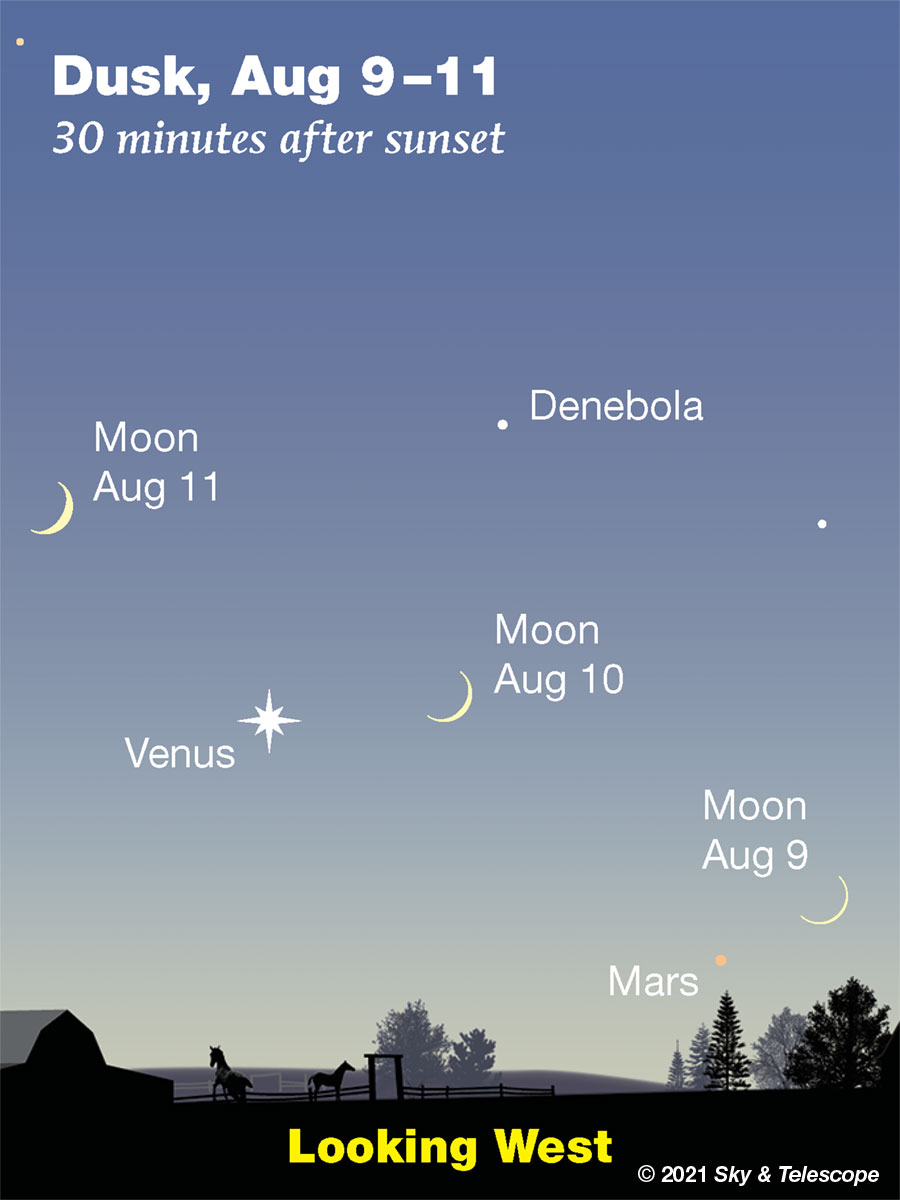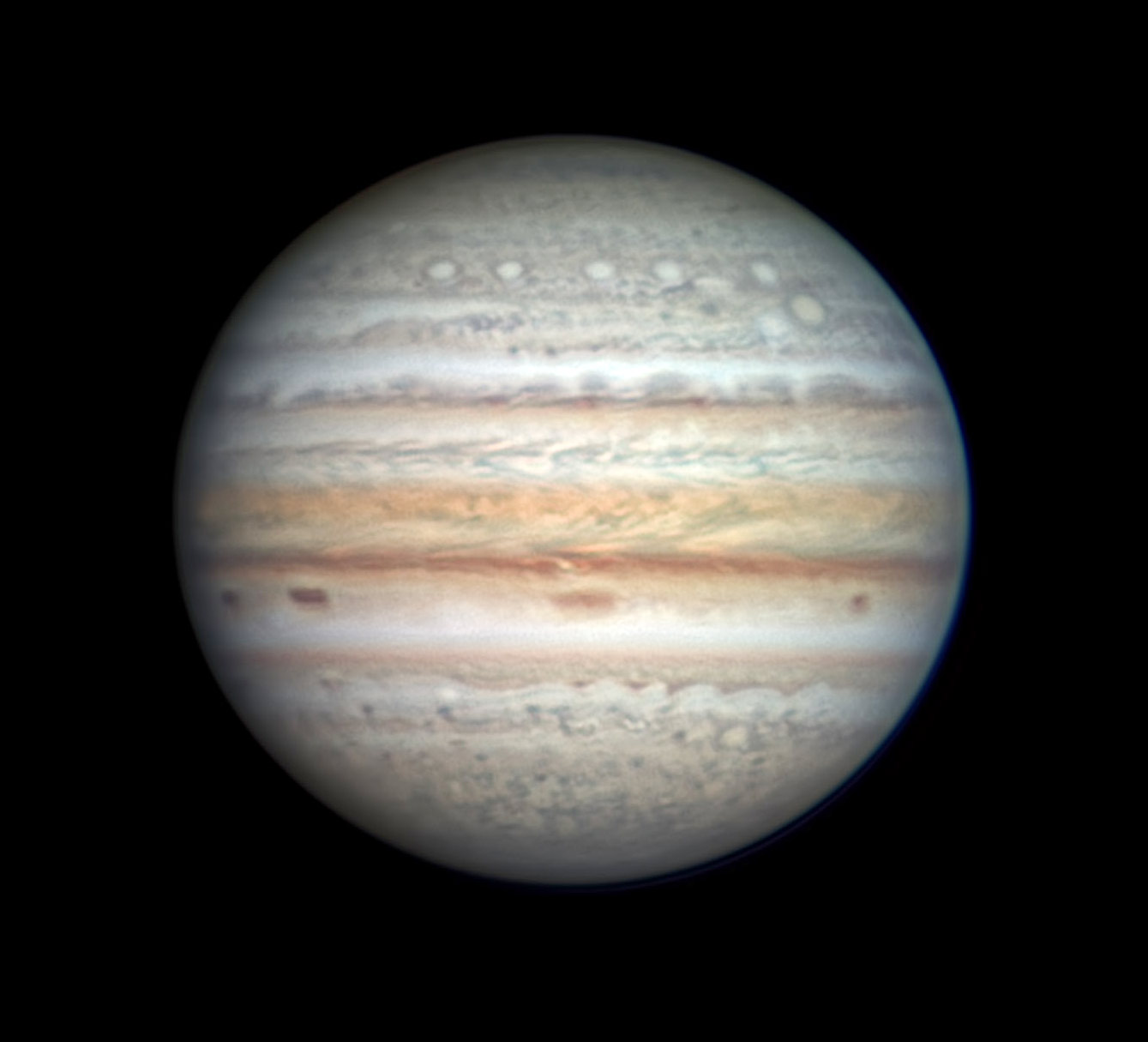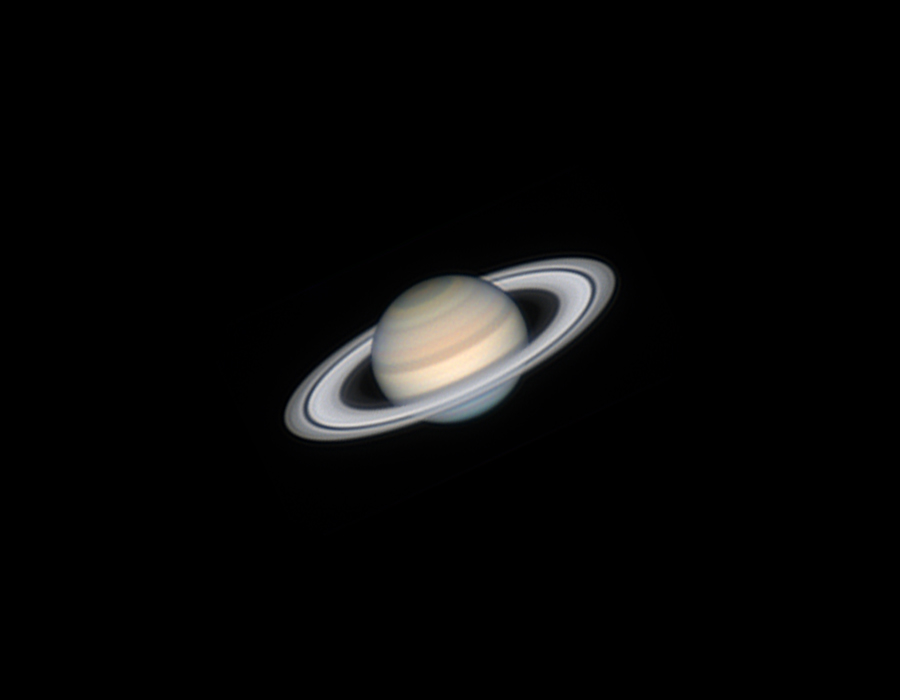Nova Cas fades. Nova Cassiopeiae 2021 has bounced around in brightness ever since erupting to magnitude 7.7 in March — including brightenings to magnitude 5.5 in early May and 6.0 around July 27th. As of August 6th it was down to about 8.1. Charts and comparison stars. It really can't keep this up forever. . . .
FRIDAY, AUGUST 6
■ Have you been seeing any Perseids meteors yet? For now you'll notice only an occasional Perseid during your observing sessions, but hang on. The shower is due to peak late this coming Wednesday night, August 11th; see that date below. Already the sky is moonlessly dark.
How do you tell a Perseid from a random sporadic meteor or a member of one of the lesser showers that are currently active, the Delta Aquariids and the Kappa Cygnids? Just trace its path backward far across the sky. Does this line cross a point in northern Perseus below Cassiopeia? That's the radiant of the Perseids: their perspective point of origin if you could see them approaching from the far distance.
In reality you can see them only at their last moment as they plunge into Earth's atmosphere — and that can happen anywhere in your sky.
SATURDAY, AUGUST 7
■ Bright Vega passes closest to overhead around 10 or 11 p.m. now, depending on how far east or west you are in your time zone.
How closely it misses your zenith depends on how far north or south you are. It passes right through your zenith if you're at latitude 39° north (Washington DC, Cincinnati, Kansas City, Lake Tahoe). How closely can you judge this just by looking?
Deneb crosses closest to the zenith two hours after Vega. But to see Deneb exactly straight up you need to be farther north, at latitude 45°: Portland, Minneapolis, Montreal, southern France, northern Italy.
SUNDAY, AUGUST 8
■ This is the time of year when the Big Dipper scoops down during evening, as if to pick up the water that it will dump from high overhead early next spring.
■ New Moon (exact at 9:50 a.m. EDT).
MONDAY, AUGUST 9

■ As twilight fades after sunset, look for the very thin crescent Moon coming into view far to the right or lower right of Venus, as shown above.
Low, distant Mars, 3° or 4° left or lower left of the Moon for North Americans, will be a challenge indeed. It's nearly on the far side of the Sun from us and only magnitude 1.8, and it's swamped by thick air and low-altitude twilight.
TUESDAY, AUGUST 10
■ Now the crescent Moon shines to the right of Venus in twilight, as shown above.
■ If you use a telescope much you're probably familiar with Lyra overhead, harboring Vega, the Double-Double, and the Ring Nebula among other sights. And nearby is Albireo, the beak of Cygnus and one of the sky's finest gold-and-blue double stars.
But between Albireo and Lyra, what about the much-overlooked globular cluster M56? At magnitude 8.3 you might even be able to detect it with large binoculars in a dark sky. To pinpoint the spot, hone in with Matt Wedel's "Lost in Space," his Binocular Highlight column and chart for this lesser-known find in the August Sky & Telescope, page 43.
WEDNESDAY, AUGUST 11
■ The Perseid meteor shower should peak late tonight, and there's no moonlight to interfere!
Early in the evening the meteors will be rather few, because the shower's radiant will still be low (in the northeast). But for that same reason, early-evening Perseids overhead will be unusually long as they graze sideways through the uppermost atmosphere. Later in the night the meteors will become more numerous (and shorter) as the radiant rises high and they plunge more directly downward. The best show will be from about 11 or midnight until the first light of dawn on the 12th; the later the better.
Layer up warmly even if the day was hot; remember about radiational cooling under a clear open sky. A sleeping bag will serve for warmth and mosquito armor; use DEET where you remain exposed.
Bring a reclining lawn chair to a dark, open spot where no local lights get in your eyes. Lie back, and gaze up into the stars. Be patient. As your eyes adapt to the dark, you may see a meteor every few minutes during the evening, and every minute or so on average as the morning hours advance. You'll see fewer under light pollution, but the brightest ones will still shine through. The best direction to look is wherever your sky is darkest, usually overhead.
For much more see Bob King's Fine Show Expected from the Perseid Meteor Shower. And you can follow the International Meteor Organization's activity graph of the shower so far. It's based on visual meteor counts reported by observers around the globe, performed by carefully standardized methods to make them inter-comparable.
THURSDAY, AUGUST 12
■ The curve of the crescent Moon this evening points toward Venus some two fists at arm's length to the Moon's lower right. Look for fainter Spica about half as far to the Moon's left.
■ In good seeing, a telescope should show the tiny black shadow of Jupiter's moon Io leaving Jupiter's western edge at 10:14 p.m. EDT (start looking earlier!), closely followed by Io itself budding off from Jupiter's edge 10 minutes later.
■ The Big Dipper hangs diagonally in the northwest after dark. From its midpoint, look to the right to find Polaris (not very bright) glimmering due north as always.
Polaris is the end of the Little Dipper's handle. The only other Little Dipper stars that are even moderately bright are the two forming the outer end of its bowl: 2nd-magnitude Kochab and 3rd-magnitude Pherkad. On August evenings you'll find them to Polaris's upper left (by about a fist and a half). They're called the Guardians of the Pole, since they ceaselessly circle around Polaris through the night and through the year.
FRIDAY, AUGUST 13
■ As the stars come out, look for Spica lower right of the Moon. They're less than a fist at arm's length apart. High to their upper right shines Arcturus.
SATURDAY, AUGUST 14
■ The brightest star high in the southeast these evenings is Altair, with little orange Tarazed above it by a finger-width at arm's length. A little more than a fist-width to Altair's left is delicate Delphinus, the Dolphin, leaping left.
Above Altair, slightly less far, is smaller, fainter Sagitta, the Arrow. It too is pointing leftward.
This Week's Planet Roundup
Mercury is buried deep in the sunset, lower right of dimmer Mars.
Venus (brilliant at magnitude –3.9) shines due west during twilight. It sets around twilight's end.
Mars is deep in the sunset, very far to Venus's lower right.
Jupiter and Saturn shine in the southeast in late twilight and after dark. They're magnitudes –2.9 and +0.2, respectively, in or near Capricornus. Jupiter starts the night lowest. Saturn glows yellowly 19° (about two fists at arm's length) to Jupiter's upper right. The pair levels out around 11 or midnight daylight-saving time. By then they're nearly at their highest in the south, at their telescopic best.
Saturn reached opposition on August 1st. Jupiter will do so on August 19th. So this month they're at their closest, biggest, and brightest of the year. See "Saturnian Challenges" starting on page 52 of the July Sky & Telescope, also "Action at Jupiter" in the August issue, page 50, and "Dog Days with the Gas Giants" on page 40 of August.


Uranus (magnitude 5.7, in Aries) is well up in the east after midnight.
Neptune (magnitude 7.8, at the Aquarius-Pisces border 24° east of Jupiter) is high in the southeast to south in the early-morning hours.
All descriptions that relate to your horizon — including the words up, down, right, and left — are written for the world's mid-northern latitudes. Descriptions that also depend on longitude (mainly Moon positions) are for North America.
Eastern Daylight Time, EDT, is Universal Time minus 4 hours. Universal Time is also known as UT, UTC, GMT, or Z time. To become more expert about time systems than 99% of the people you'll ever meet, see our compact article Time and the Amateur Astronomer.
Want to become a better astronomer? Learn your way around the constellations. They're the key to locating everything fainter and deeper to hunt with binoculars or a telescope.
This is an outdoor nature hobby. For an easy-to-use constellation guide covering the whole evening sky, use the big monthly map in the center of each issue of Sky & Telescope, the essential magazine of astronomy.
Once you get a telescope, to put it to good use you'll need a detailed, large-scale sky atlas (set of charts). The basic standard is the Pocket Sky Atlas (in either the original or Jumbo Edition), which shows stars to magnitude 7.6.

Next up is the larger and deeper Sky Atlas 2000.0, plotting stars to magnitude 8.5; nearly three times as many. The next up, once you know your way around, are the even larger Interstellarum atlas (stars to magnitude 9.5) or Uranometria 2000.0 (stars to magnitude 9.75). And be sure to read how to use sky charts with a telescope.
You'll also want a good deep-sky guidebook, such as Sky Atlas 2000.0 Companion by Strong and Sinnott, or the bigger (and illustrated) Night Sky Observer's Guide by Kepple and Sanner.
Can a computerized telescope replace charts? Not for beginners, I don't think, and not on mounts and tripods that are less than top-quality mechanically, meaning heavy and expensive. And as Terence Dickinson and Alan Dyer say in their Backyard Astronomer's Guide, "A full appreciation of the universe cannot come without developing the skills to find things in the sky and understanding how the sky works. This knowledge comes only by spending time under the stars with star maps in hand."
![]() Audio sky tour. Out under the evening sky with your
Audio sky tour. Out under the evening sky with your
earbuds in place, listen to Kelly Beatty's monthly
podcast tour of the heavens above. It's free.
"The dangers of not thinking clearly are much greater now than ever before. It's not that there's something new in our way of thinking, it's that credulous and confused thinking can be much more lethal in ways it was never before."
— Carl Sagan, 1996
"Facts are stubborn things."
— John Adams, 1770
 5
5









Comments
Rod
August 6, 2021 at 9:32 am
mary beth et al. I had some very enjoyable summer nights on Wednesday evening and last night. I used my 90-mm refractor telescope and the 10-inch Newtonian. Last night guest were over and enjoyed the heavens. Saturn was a favorite target, Jupiter. We enjoyed M8, M11, M22, and the wonderful colors of the double star Albireo in Cygnus. Skies were clear and cooler temps down in the low 60s but weather warming up again now. As the gentleman who was over with his wife last night said after viewing Saturn and other targets in my 10-inch, *the view was well worth the price of admission* 🙂
You must be logged in to post a comment.
New Jersey Eclipse Fan
August 6, 2021 at 5:22 pm
You're too generous. I would've charged 10 times that.
You must be logged in to post a comment.
mary beth
August 8, 2021 at 12:10 pm
Very nice you had the refreshing cool air! Please send some to Texas! Even though it has been so hot and cloudy/humid during the day, the clouds quickly dissipate at sunset and we have had some clear, gorgeous nights. I can’t get over how quickly things start clearing off and it’s kind of fun to watch the clouds swiftly departing, and then start seeing the stars one by one. Very nice last night with three bright planets. I’m glad your guests got to enjoy such a nice treat! Countdown onto the Jupiter opposition, and this week we can enjoy the crescent moon!
You must be logged in to post a comment.
cyrtonyx
August 11, 2021 at 8:38 pm
While driving to work early this morning (Aug 11) saw a bright bolide streaking N to SW. It was bright enough to cast a shadow on the interstate. Maybe a Perseid?
You must be logged in to post a comment.
mary beth
August 12, 2021 at 11:22 am
How fortunate! I bet so since the radiant is Northerly!
You must be logged in to post a comment.
You must be logged in to post a comment.